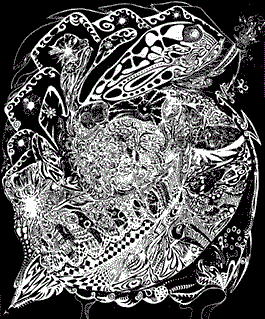| << UbuWeb |
| Aspen no. 3, item 11 |
|
|
| The Plastic Exploding Inevitable |
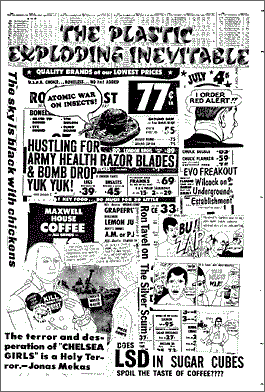
|
• Ron Tavel on The Silver Scum • The terror and desperation of "Chelsea Girls" is a Holy Terror, by Jonas Mekas • Slum Goddess, from the East Village Other • Allen Ginsberg on political action, from the East Village Other • Hustling For Army Health Razor Blades & Bomb Drop Yuk Yuk by Gerard Malanga • Bobby, and Barbie and Ken in the Cat's Pink Mouth, by Patricia Oberhaus, from the Berkeley Barb • EVO Freakout by John Wilcock • What Is Joint Art, from the LA Free Press |
|
Ron Tavel on The Silver Scum |
|
Once when Kenneth Anger was 18 years old, his parents went away for the weekend leaving him in charge of the family house. He immediately summoned all the friends he could think of, got hold of a wardrobe of sailor outfits, and shot a film, "Fireworks," an opus that remains to date his most straightforward and sincere. With daring zooms and electrifying worm's-eye-views that shutter down like the collapsing folds of a fan, he exposed with unabashed innocence the nightmare limitations of a youth who craves the sadistic assault of an entire navy in place of the paranoiacally lost union with humanity. The ultimate in wishful hoping is achieved at the movie's climax, when a sailor's fly opens out into a gigantic Christmas tree that pierces the hero through and through. "Fireworks" set a tone and a standard that were to throw a long shadow across the upcoming generation of independent American filmmakers. Its photographic innovations and uncensored subject matter are the pride and joy of these artists, while its visionary shortcomings would seem to be symbolic of the fractured lives led by most of these movie people. Anger grew up in California, surrounded by the myth of Hollywood, (which he would later take to task in his hook, "Hollywood Babylon," an incredibly paranoid interpretation of our indigenous mythology), and nearly all the Underground directors evince the prodigious influence of the West Coast fantasy-world. Anger's films became popular on the university circuit, which brought him meager financial returns, but it was not until the release of "Scorpio Rising," his most commercial and least artistic work, that he was ironically awarded a $10,000 grant and placed in a securer as well as more artistically accepted position. Furthermore, "Scorpio Rising," a 45-minute film replete with the sensational distrust of human beings seen through the bored, non-fluid eye of a repetitively right-angle camera movement, became the box-office draw of the Underground world and rescued not only Anger but several cinematheque houses across the country. CONTINUED: Silver Scum |
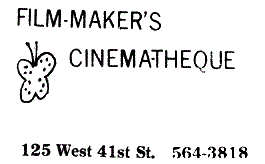
|
|
|
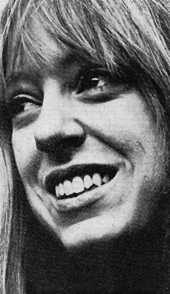
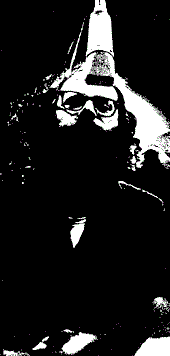
• Allen Ginsberg, would you be interested in running for political office? • Yes. Except that I'm too busy writing poetry. I almost wish I'd run against Farbstein. • How, in a political society, can the politically uncommitted change the structure for the better? • First of all like Krishnamurti said this week a psychic revolution is taking place—or it should take place—which would then realign, rearrange human relahonships presumably, as he said, to imageless contact. • So I go and sit and listen to Krishnamurti. Same time I went down to Varick St. an the 27th, voting day, to get a judge, fine, and imagepaper so I could vote against the Vietnam war. In the East Village if all 2,500 people at the Leary assemblage that night hod voted we would have got a peace candidate, maybe full of images, but anyway the word peace instead of the word war implanted in newspaper consciousness. In this locality if every junkie, faggot, teahead, spade, beatnik, LSD-soul, utopian/meths freak fug groupie, Bhaktivedanta devotee, Incorruptible Indifferent seeker and lazy bastard would literally register their persons at the Board of Elections on Varick St. we could inaugurate a community that might lead the wayin America: we could have one representative in Congress and a bunch of our own agents at City Hall and Albany. 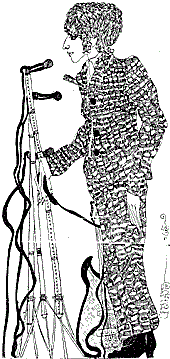
|
|||||
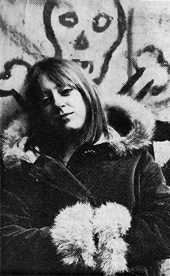
|
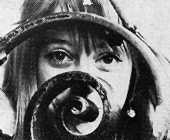
Suze Rotolo, age 22: "If a man can learn to develop all his inherent and latent powers there is nothing that he will not be able to apprehend. For the knowledge of everything is in man in the same way it is in God. Only a heavy veil of darkness hides it from view and prevents his seeing these things and understanding them. ""Arthur Rimbaud said that, and that's all I want to say. Because if you look at it close enough it answers the three questions: How come the Lower East Side? Men in general? What I do? ""I live on the Lower East Side because I like the new. I want my man to have a toothpick in his ear and a purple boot on his right foot. I do artist and earn money when I do." |
|||||
|
HUSTLING FOR ARMY HEALTH RAZOR BLADES & BOMB DROP YUK YUK By GERARD MALANGA, poet-laureat, whip-dancer What's happening in modern poetry? Plenty. Let's first of all be very clear however as to the kinds of poetry being discussed. My point of departure in this essay is going to be page one of the Grove Press "Anthology of American Poetry, 1945-60." There are, I suppose, some decent poets in all those other Robert Pack etc. anthologies, but no one in his right mind could possibly mistake even the best of them for a "modern" poet. In fact, one may even question the nationality of such poets (as for example Richard Wilbur, Robert Lowell, etc). So, so much for them. The Grove Press anthology, despite all the crap it contained, and despite certain hideous omissions, served wonderfully to clear the air of all the noisy emptiness in it, and at the same time threw up into the air a goodly portion of all the modern and American poetry that was being written. (Alas, the editor somehow found reason not to include Kenneth Rexroth, Kenneth Patchen, Louis Zukofsky and Edwin Denby, all of whose poetry is vital to any understanding of the terms "modern" and "American" in relation to poetry. Which is not even to mention the fact that Edwin Denby, the least known of those four, probably is one of the two or three greatest living American poets.) Here is a sampling of his work, concerned with interiors and exteriors, the weather, and the urban environment:
Certain arbitrary divisions into groups were made in that Grove Press anthology, for purposes of simplification, i.e. to "locate" the various poets in "schools" etc, if there were any, which there were. This wasn't a bad idea, really, though naturally it made for certain misleading connections which would have to be straightened out later in order to properly chart the various streams of development for anyone interested. It is possible now, in 1966, to take a close look at that Grove anthology and its various divisions in light of the passing of six years, and thus to see not only what has been happening since 1960, but also to get a better, more accurate picture of what was happening before then. CONTINUED: Bomb Drop Yuk Yuk |
||||||
|
The Fire Oh flame falling, as shaken, as the stories
|
|
Olson, of course, never was a Black Mountain poet, and he remains now what he was in the past, that is, Charles Olson. To a certain degree Olson is like the painter Hans Hofmann. He is a very good poet indeed, a great and inspiring person and teacher and, like Hofmann, Olson's inspiration generally sends one off in one's own direction rather than making one into an Olson imitator. Here are the opening stanzas of one of Olson's greatest poems, and the most memorable from his series entitled The Maximus Poems. The poem, entitled "Maximus, To Himself" is a monologue-dialogue, in the sense that Olson becomes the person addressing as well as the person being addressed: |
|
I have had to learn the simplest things
The sea was not, finally my trade.
that we are all late in a slow time that we grow up many and the single is not easily known. |
|
Of a whole host of San Francisco poets, and I forget just what school they were supposed to be, the comparable leaders, a la Creeley and Olson, were Jack Spicer and Robert Duncan. Jack Spicer, who died recently, is still an influence over quite a number of San Francisco poets, most of whom are, alas, boring. This short poem is from his fourth book, "Language": |
|
A redwood forest is not invisible at night. The blackness covers it but it covers the blackness. If they had turned Jeffers into a parking lot, death would have been eliminated and birth also. The lights shine 24 hours a day on a parking lot. True conservation is the effort of the artist and the private man to keep things true. Trees and the cliffs in Big Sur breathe in the dark. Jeffers knew the pain of their breath and the pain was the death of a first-born baby breathing. Death is not final. Only parking lots. |
|
Robert Duncan too is a force in poetry, as a kind of older master, both through his own work and because of his immense| energies. His own poetry has remained much the same since 1960, and it is his older poetry that exerts influence (as it did over John Wieners, LeRoi Jones, and more recently Robert Kelly, for example). |
|
SONNET 1 Now there is a Love of which Dante does not speak unkindly
who lust after men and run —his beloved Master, Brunetto Latini, among them—
like the hum of bees in the hot sun.
to look to one another
in the light of a new moon look.
seeking to thread a needle
Love has appointed there
|
|
Some other San Francisco poets, notably two, are terrifically active, alive, important to younger poets, and what-have-you. These two are Phil Whalen and Gary Snyder, both now living in Japan. Both have published lots of works since 1960, both have been featured prominently in all the new magazines that have sprung up since 1960, and both are mentioned plenty when the younger poets discuss not gurus but poetry and poets. Here are brief examples of their work: |
|
RIPRAP Lay down these words
placed solid, by hands In choice of place, set
in space and time: Solidity of bark, leaf, or wall riprap of things: Cobble of milky way, straying planets, These poems, people, lost ponies with Dragging saddles — and rocky sure-foot trails. The worlds like an endless four-dimensional Game of Go. ants and pebbles In the thin loam, each rock a word a creek-washed stone Granite; ingrained with torment of fire and weight Crystal and sediment linked hot all change, in thoughts, As well as things. by Gary Snyder |
|
TUESDAY, JULY 25,1961 hoist great blocks of language into place A fabric of elegant proportion, exquisitely adorned with garlands, columns, urns one chaste Roman statue in a niche Wherein the lives & feelings of a motley crew sparkle, flare, shout, gasp & tinkle Disperse into foreign cities ancient gaudy jeweled kingdom of the east...
the pinnace in the wooded bay the final Journey to Cythera by Philip Whalen |
|
And finally, in San Francisco; there is Mike McClure, who has flipped out onto the beast track who is somehow a right-wing experimentalist, a very interesting person and poet, (a very beautiful person to look at) whom nobody imitates but everybody watches. Instead of commenting on his work, I'll quote the poet's own words from his introduction to the Ghost Tantras:
Here is a musculine-masculine example from The Beast Sound: |
|
GOOOOOOR! GOOOOOOOOO!
|
|
Just as a footnote to this group, it is interesting to note that the poet Philip Lamantia, (currently on one of his frequent long-term stays in Europe — presently residing in Malaga, Spain) still exerts his magic influence over poets from Maine to Carmel, just a few here and there, despite the feet that he is rarely heard from. Here are the first and last stanzas from one of his most recent poems: |
|
The Sun is Bleeding Over the Sky!
Youth's dream to burn down the dreads of dope and dour old men's sickly sex and sicker greeds! |
|
The Beats, I am happy to say are flourishing. Allen Ginsberg is now the best-known poet in America. Further, he is ten times as good a poet as when he wrote "Howl" and God bless him as Charles Olson said at Berkeley last summer, "Allen, you are our leader." His India poems are wonderful. Here is an example of his most recent work, "Carmel Valley", written at Joan Baez' house at Big Sur: |
|
Yellow grass on a hill blue mountain ranges, blue sky, bright reservoir & road below, tiny cars — The wing tree green sigh of the wind rises and falls — Buddha, Christ, fissiparous Tendencies, White sun rays piercing my eyeglasses — The grey bark animal arms, skin peeling, fingers pointing, twigs trembling, green thin plates bobbing sprouted from knotted branches — No one will have to announce the New Age — No Special name, No Unique Way, no Crier by Method or Herald of the Snaky Unknown, No Messiah necassary but the Country and ourselves fifty years old — Allah this tree, Eternity this Space Age: Teenagers walking thru Times Sq. neon & metal look up at blue planets thru buildingtops, Old men lay out on the grass afternoons, old Walnut stands above them, ants crawl on the page, the mountain hide is covered with green skin and invisible singing insects, birds flap out, Man will relax and sit on the hill remembering his tree friends. |
|
Peter Orlovsky, Allen's magic double, despite the paucity of his actual writing output, is one of the most original rewarding and talented poets in America. He is a kind of terrifically virile American Max Jacob, religious vision and all, and may outlast us all in terms of Keatsian fame. Here is the opening of his most well-known poem, "Second Poem": |
|
Morning again, nothing has to be done,
At least clean the room up, for sure like my farther I've done flick the ashes & buts over the bedside on the floor. But first of all wipe my glasses and drink the water to clean the smelly mouth. A nock on the door, a cat walks in, behind her the Zoo's baby elephant demanding pancakes — I cant stand these hallucinations any more. Time for another cigarette and then let the curtains rise, then I knowtice the dirt makes a road path to the garbage pan. No icebox so a dried up grapefruit. Is there any one saintly thing I can do to my room, paint it pink maybe or instal an elevator from the bed to the floor maybe take a bath in the bed? What's the use of living if I cant make paradise in my own room-land? For this drop of time upon my eyes like the endurance of a red star on a cigarette makes me feel life splits faster than scissors. |
|
And the third king beatnik Gregory Corso, having gone thru the mills of marriage, addiction to junk, his usual charlatanry and considerably more assininity than usual, plus having published two books since the great Gasoline that were more boring than not (tho containing marvelous stuff too of course), recently published a genius book in an edition of 100 copies titled The Mutation of the Spirit that is almost better than anything he has ever done. I guess Gregory will never develop in an ordinary manner, but it is now obvious that sporadically he will astound everyone by producing authentic timeless works of great American genius as he was obviously meant to do. Here is the ending of one of his most/memorable shorter poems, "Uccello", the poet's commentary upon looking at one of Uccello's paintings and wishing to take part in the battle crusade depicted: |
|
You'd think it impossible for any man to die each combatant's mouth is a castle of song
like cries of gold how l dream to join such battle!
lance never to die but to be endless a golden prince of pictorial war |
|
Jack Kerouac, still not known as a poet, and, despite what Allen says about Mexico City Blue it is something less than great poetry, somehow nevertheless IS a great poet. Here is "211th Chorus" from his Mexico City Blues: |
|
The wheel of the quivering meat conception
Illuminating the sky of one Mind —
|
|
Desolation Angels was as good as anything he has ever done and believe you me, folks, Jack Kerouac is THE great American Writer as of now. I have said it. Bang. I must get finished with all these guys, as there are new poets to talk about, and truly they are what is happening in modern poetry, and that IS what we are talking about, we being me, but: here I am at the most important development among the older poets of modern American poetry. I mean The New York School. Ooops. First a pause to say that Mr. J. Wieners, NYC and San Francisco and Boston, Mass. and Buffalo, continues to roll, sweet lyrical formal and tough-minded as ever (or, to coin a phrase, "feminine, marvelous and tough.") Here is John Wieners' most feminine, marvelous and tough poem to date: |
|
Poem Don't give nothing for nothing
He gave me nothing
Lidden children of the world.
Damned and cursed before all the world;
|
|
Now, back to NYC. In the Grove Press anthology Don Allen presented the New York poets, namely Kenneth Koch John Ashbery, James Schuyler and Frank 0'Hara. Not too much space was given to this group but time has shown that in fact it was this group that was and still is the most vibrant vital active force in modern American poetry today, both in terms of influence and in actual work produced. Frank O'Hara's Lunch Poems and Love Poems, John Ashbery's The Tennis Court Oath and Rivers and Mountains, Kenneth Koch's Thank You, and lately Jimmy Schuyler's May 24th Or So are the best books to have been published since 1960. John Ashbery is a holy wonder. Time has shown that it is he, and not Olson nor Allen nor Duncan who is THE POET. In my own opinion John Ashbery is the greatest poet alive today writing in English. As a brief example of his work, here's the opening stanza in his book "Rivers and Mountains": |
|
These lacustrine cities grew out of loathing
|
|
The Yugen crowd has more or less disappeared, likewise with The Floating Bear crowd. Diane DiPrima still does this and that, with her husband, actor-model Alan Marlowe, printing books of poems and prose of her friends on the Poet's Press imprint, but it isn't really anything, and even her own tough guy lovableness as in Dinners and Nightmares has dribbled mostly away. Of the Yugen crowd, all that would seem to be left is LeRoi Jones (his picture is appearing everywhere these days! ) and since everybody thinks they know all about him (they don't) I won't say anymore, except that his System of Dante's Hell actually is what Frank O'Hara once said it was, i.e. the most exciting swinging valid and etc. experimental prose writing in America since Gertrude Stein. It is a great book. Here is a brief but poignant excerpt from the beginning of the section entitled "The Heretics": |
|
The place, they told us, we'd have to go to "ball" was called by them Bottom. The Bottom; where the colored lived. There, in whatever word less energies your lives cd be taken up. Step buck: to the edge, soothed the wind drops. Fingers are cool Air sweeps. Trees one hundred feet down, smoothed over, the wind sways. And they tell me there is one place/ for me to be. Where it all comes down. & you take up your sorrowful life. There/ with us all. To whatever death The bottom lay like a man under a huge mountain. |
|
To turn to somewhere else, Ed Dorn is still publishing, lots of people speak highly of him, but few imitate his boring unimaginative verse. His uncompromising moral stance is no doubt admirable, and so everybody admires it, and no one ever says outright that his works are boring, but they are; that's why they're great!! Maybe Ed Dorn is too specific in his naming of names and locations. There is no mystery, no magic, no questions to guess at. But I don't want to imply I've searched for instances to back up my point. Here are two brief stanzas from his poem, "Are They Dancing": |
|
There is a sad carnival up the alley
|
|
WHAT'S NEW??? Well, what is new, though maybe it isn't so new, is that what is happening is happening in New York City. Oh, there are swinging activities in Detroit, though John Sinclair, young hot-shot there, was recently busted for pot and got six months, somewhat cooling the scene, and Allen says there is activity in Wichita with Charles Plymell, and there's always a few new talents jaypopping thru San Francisco, despite the hate-wars always going on in that most provincial of big cities; but, I repeat, what's happening is happening in New York City. There the two newest and brightest of the new, heir apparent to the beats, Ed Sanders, and that presumptious young man Ted Berrigan, are publishing the two best poetry magazines in the world. Sanders is sole editor and publisher of the notorious and wonderful Fuck You, A Magazine of The Arts, and Berrigan the same sole mogul of the weird and frivolous "C", A Journal of Poetry. Between them they have all the territory covered. In fact, they do publish some of the same people, notably each other, much to everyone's surprise, plus Wieners, Ginsberg, Corso, O'Hara. But strictly speaking Ed Sanders' turf includes rights to Ginsberg, Wieners, Olson, Corso Orlovsky, McClure, etc., although Sanders' best poet is Ed Sanders himself, a young genius, whose Poem From Jail and Peace Eye are great books. "C" in truth is more swinging as far as the new discovery line goes, and with one or two exceptions all the best young poets appear there. Berrigan's book The Sonnets and Sanders' Peace Eye are the two most important new books. The following poems are from them. |
|
XXXVII
You are asleep And the beautiful tears
by Ted Berrigan |
|
Song of the Hustler
by Ed Sanders |
|
In addition I would like to recommend the works of a few young poets of extreme talent ("in extremis"), i.e. Dan Cassidy, Ron Padgett, Ingrid Superstar, David Murray, Debbie Caen and Albert Rene Ricard (most of them working in the journal-diary form structure) who are grouped around the painter Andy Warhol and myself. Of them, you're bound to hear more later! Dan Cassidy's Katz Lectures is an unpublished book manuscript I whose major concern is contemplation of a universal revolution which suggests possible good roads, and sympathetic insight into fears; and it reports flashes of hope lighting the way, even though they may not come for the next fifty years. One aspect of The Katz Lectures manuscript solution seems to be suggested in a poem whose title was suggested by a line by Allen Ginsberg. |
|
NOW IS THE TIME FOR PROPHECY
|
|
A first reading of In Advance of The Broken Arm enforces immediate respect for Ron Padgett's imagination as a technician. He knows precisely what effects he wants, and he knows how to achieve them. Here is one example: |
|
TALKING NEUTRALITY a talking song from the painter Miro Always I walk in nature... alone
|
|
Ingrid Superstar (of "Underground movie fame"), as her friends call her, has written a trip book, a sort of diary. Her writing is bad, meaning in the "Camp" sense, it's good. What is bad in Ingrid's diary is good because what she does do bad she takes seriously. The great thing about Ingrid Superstar's writing is you know it could only come from her. Here is a sampling, the opening stanzas of a personality study of her mentor, pop kid Andy Warhol: |
|
Pop Art is very uptight, but imaginatively different and has its own original manner. Up-tight means to have so many different things of interest going at the same time to attract the audiences attention, in order to confuse them (maybe intentionally or unintentionally) Andy is very congenial, always agreeing with everything, probably just to avoid a hassle. Always chews gum, esp. when he's up there. His poor teeth. Never knows anything. Quote: "I don't know, soon, maybe." Usually indirect, as you can see. Usually quiet, shy and observant at first, with a cute smile. (It's the quiet ones and the sweet sneaks that you have to look out for) |
|
One further new magazine that must needs be mentioned is Aram Saroyan's Lines, now defunct, of which there were six issues. Aram Saroyan is a weird cat, publishes and writes Concretist poetry (plus real poetry), and is a thick-headed sort of fellow, but is a marvelous young poet who alas can't be avoided. Here are some examples from his Concrete poetry: |
|
13 wwww wwww ...... waww wakw wake ...... walw walk 14 school fffishffish ffifisfish ffisfish 15 eyeye |
|
Then there's David Murray in his David Murray's Journal, a Swiftian dream journal accumulation of his travels, his sexual escapades and the people he has encountered in his life. The effect David Murray achieves is making Love an allembracing physical and psychological act in modern literature. Readers may find David Murray's journal offensive or perverse, but this is only felt on the surface because David's prosaic style is untrim, opaque, somewhat defecating but equally lyrical and colorful. Now we come to a very significant diary by a heroine of our age, Debbie Caen. Debbie's diary is probably one of the most significant pieces of prose writing by a young person to come out of America since Huncke's Journal. What makes the diary important, are the insights and the revelation of an extraordinarily sensitive and lucid but also tormented amphetamine spirit, a spirit effected by the impulse of an isolation, but not over that edge that prevents us from hearing and reading what Debbie Caen has to say of the personal crises that surround her and her friends: |
|
We live a life void of holidays and surrounded by our twins we crowd our heads with sound so loud, it fills our tender, pinkish brains as water fills a lost bottle. Sometimes I wonder if I am the joke and she merely another prop, pushing me, downward. Until final blackness, my only path. No more. The one last chance, never again the opportunity to retreat. I missed you by only two blocks. |
|
The poems of Albert Rene Ricard have been justly praised by almost everyone n "the Underground". In his only unpublished slim book manuscript, we find a sophistication and technical structure almost unequaled among his contemporaries or his elder mentors, including John Wieners whom he looks toward as his guiding spirit. Albert Rene Ricard's themes are completely about one subject: love and hate. Ricard is probably the most interesting of all the recent young American poets, if only because of his Underground personality reputation as catalyst and pretty boy which he has consistently maintained for years in Cambridge, Boston, Provincetown, Montreal, and New York. |
|
"The Stones Have Begun Making Me Sick"
But it stopped a week ago
|
|
Original format: Eight page newsprint tabloid, 11-1/2 by 17 inches. Numerous photos are omitted here to reduce download time. |
|
|
|
|
|
|
|
